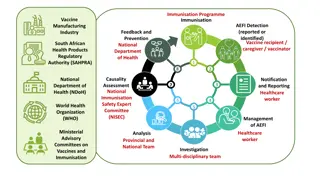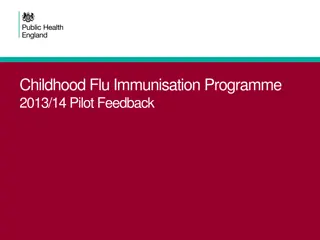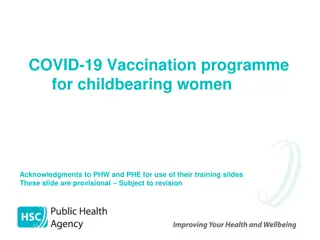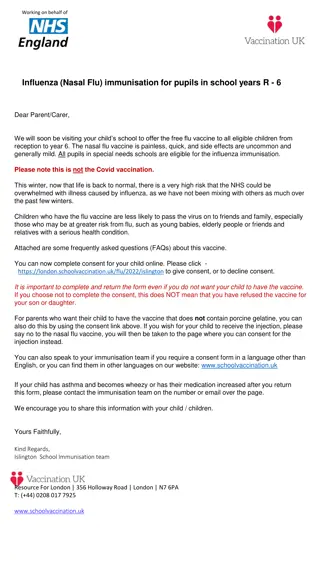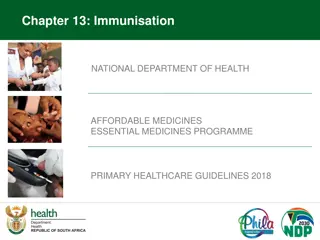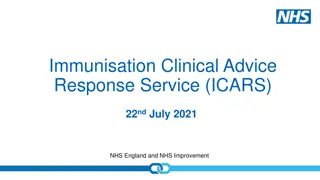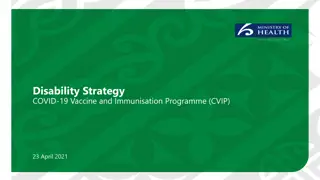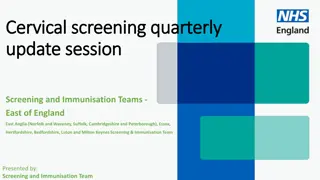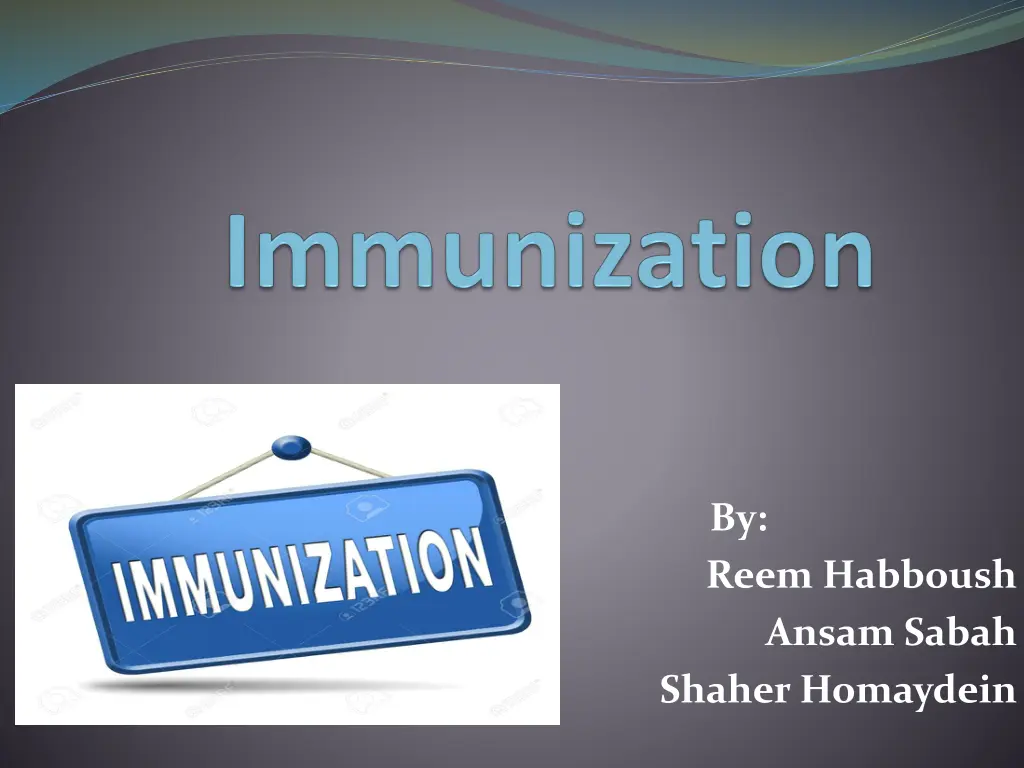
Understanding Vaccination: Types of Immunity, Immunization Process
Explore the world of vaccination with a detailed overview of immunity types, vaccination processes, and general precautions. Learn about active and passive immunity, vaccine administration, and adverse reactions. Unveil the history of vaccination and its significance for public health.
Download Presentation

Please find below an Image/Link to download the presentation.
The content on the website is provided AS IS for your information and personal use only. It may not be sold, licensed, or shared on other websites without obtaining consent from the author. If you encounter any issues during the download, it is possible that the publisher has removed the file from their server.
You are allowed to download the files provided on this website for personal or commercial use, subject to the condition that they are used lawfully. All files are the property of their respective owners.
The content on the website is provided AS IS for your information and personal use only. It may not be sold, licensed, or shared on other websites without obtaining consent from the author.
E N D
Presentation Transcript
By: Reem Habboush Ansam Sabah Shaher Homaydein
Outline: Objectives Definition of Immunity Types of immunity vaccination Routs of administration Vaccines on schedule The process General precautions to be taken Adolescents vaccines Vaccinations for special health status persons Vaccines Adverse Reactions
Objectives: At the end of this lecture, the students will be able to: Define core concepts (immunization, vaccination) 2. Identify types of vaccination clearly. 3. List 2-3 of general precautions should be taken correctly. 4. Summarize the steps of vaccination process. 5. Identify vaccines adverse reactions. 1.
Immunization: Immunization is the process of inducing immunity artificially by either vaccination (active immunization) or administration of antibody (passive immunization).
Types of Immunity Specific defenses Immunity Active immunity Passive immunity natural Following clinical infection Transfer of maternal Antibodies Through placenta Following subclinical infection Transfer of maternal Antibodies Through milk acquired Following administration of Immunoglobulin or antiserum Following vaccination
Active immunity Resistance developed in response to stimulus by an antigen (infecting agent or vaccine) and is characterized by the production of antibodies by the host.
Passive immunity Immunity conferred by an antibody produced in another host. It may be acquired naturally or artificially (through an antibody-containing preparation).
Vaccination Vaccination is a method of giving antigen to stimulate the immune response through active immunization. A vaccine is antigenic but not pathogenic .
History of vaccination Historical recordings of attempts of vaccination from 7thcentury but not really recognised or successful until: 1796: Edward Jenner demonstrated that inoculation with cowpox virus produced protection from infection with smallpox. (Hence Vaccination : taken from vacca the Latin word for cow) 1860s-1890s: Louis Pasteur produced vaccines against chickenpox, cholera, diphtheria, anthrax and rabies
History of vaccination Early 20thCentury: Toxoid vaccines against diphtheria and tetanus produced. Post World War 2: successful live viral vaccines developed using cell culture techniques Present and future: new technologies constantly developing: recombinant protein vaccines, DNA and conjugate vaccines
Types of vaccines Live attenuated vaccine Live vaccines Inactivated (killed vaccines) Toxoids Cellular fraction vaccine Surface antigen (recombinant) vaccines.
Live attenuated vaccines These vaccines contain a version of living virus that has been weakened so that it does not cause serious disease in people with healthy immune system (example: MMR)
Live vaccines Live vaccines are made from live infectious agents without any amendment. The only live vaccine is Variola small pox vaccine.
Inactivated (killed) vaccines Organisms are killed or inactivated by heat or chemicals but remain antigenic. Usually safe but less effective than live attenuated vaccines. The only absolute contraindication to their administration is a severe local or general reaction to a previous dose.
Toxoids They are prepared by detoxifying the exotoxins of some bacteria rendering them antigenic but not pathogenic.
Surface antigen (recombinant) vaccines. It is prepared by cloning HBsAg gene in yeast cells where it is expressed. HBsAg produced is then used for vaccine preparations. Their efficacy and safety also appear to be high.
Types of vaccines Live vaccines Live Attenuated vaccines Killed Inactivated vaccines Toxoids Cellular fraction vaccines Recombina nt vaccines Small pox variola vaccine BCG Typhoid oral Oral polio Yellow fever Measles Mumps Rubella Intranasal Influenza Typhoid Cholera Pertussis Rabies Intra muscular influenza Diphtheria Tetanus Meningococcal polysaccharide vaccine Pneumoccocal polysaccharide vaccine Hepatitis B polypeptide vaccine Hepatitis B vaccine
Diseases Caused by Bacteria Diphtheria Haemophilus influenza type b Meningococcal disease Pertussis Pneumococcal disease Tetanus
Diphtheria Hib
Diseases Caused by Viruses Hepatitis A Hepatitis B Shingles Human papillomavirus(HPV) Influenza Measles Mumps Rotavirus Chickenpox Polio
Hepatitis b Mumps Measles
Routes of administration Deep subcutaneous or intramuscular route (most vaccines) Oral route (Sabine vaccine, oral BCG vaccine) Intradermal route (BCG vaccine) Scarification (small pox vaccine) Intranasal route (live attenuated influenza vaccine)
The Jordanian National Immunization Program Recommended Vaccines First Month 61 Days 91 Days 121 Days 9 Months 18 Months 6 Years (First Grade) 15 Years (10th Grade) Td Age BCG DPT-HBV-Hib DPT-HBV-Hib DPT-HBV-Hib Measles DPT Td IPV IPV OPV OPV OPV OPV OPV MMR
The process (nursing roll): Assess the patient s immunization history Check the recommended immunization schedule Screen for contraindications and precautions Educate the parent and patient Administer all needed vaccines Document administered vaccines Inform parents and patients when vaccines are needed next
GENERAL PRECAUTIONS TO BE TAKEN: The risk of adverse reactions can be reduced by proper sterilization of syringes and needles, by proper selection of the subject and the product. Measles and BCG vaccines should be reconstituted only with the diluents supplied by the manufacturer.
Reconstituted vaccine should be discarded at the end of each immunization session and NEVER retained for use in subsequent sessions. In the refrigerator of the immunization centre, no other drug and substances should be stored beside vaccines. Training of immunization worker and their close supervision to ensure that proper procedures are being followed are essential to prevent complications and deaths following immunization.
Four Vaccines Are Recommended for ALL Preteens at age 11 or 12 years Tetanus-diphtheria-acellular pertussis vaccine (Tdap) Meningococcal conjugate vaccine (MCV4) Human papillomavirus vaccine (HPV) Influenza (flu) vaccine
Vaccines Recommended for Adolescents Polio Hepatitis B MMR Hepatitis A
Vaccines Recommended for Adolescents with High-Risk Conditions Pneumococcal conjugate vaccine (PCV13) Pneumococcal polysaccharide vaccine (PPSV23)
Vaccinations for special health status persons: Immuno-compromised persons ( Leukemia, lymphoma, HIV, malignancy ) Hemodialysis and transplantation should receive the following vaccines according to their situation: HBV, Influenza, Pneumococcal vaccines
Vaccine Adverse Reactions Adverse reaction extraneous effect caused by vaccine "side effect" Adverse event any event following a vaccine may be true adverse reaction may be only coincidental
Vaccine Adverse Reactions Local pain, swelling, redness at site of injection common with inactivated vaccines usually mild and self-limited Systemic fever, malaise, headache nonspecific may be unrelated to vaccine
Conclusion: Immunization is one of the most cost-effective health interventions. Investing in vaccines SAVES more money than it costs.
References: www.pitt.edu.com medicine.missouri.edu/childhealth https://www.cdc.gov/primarycare/.../adolescent_vacci nes_module.ppt

